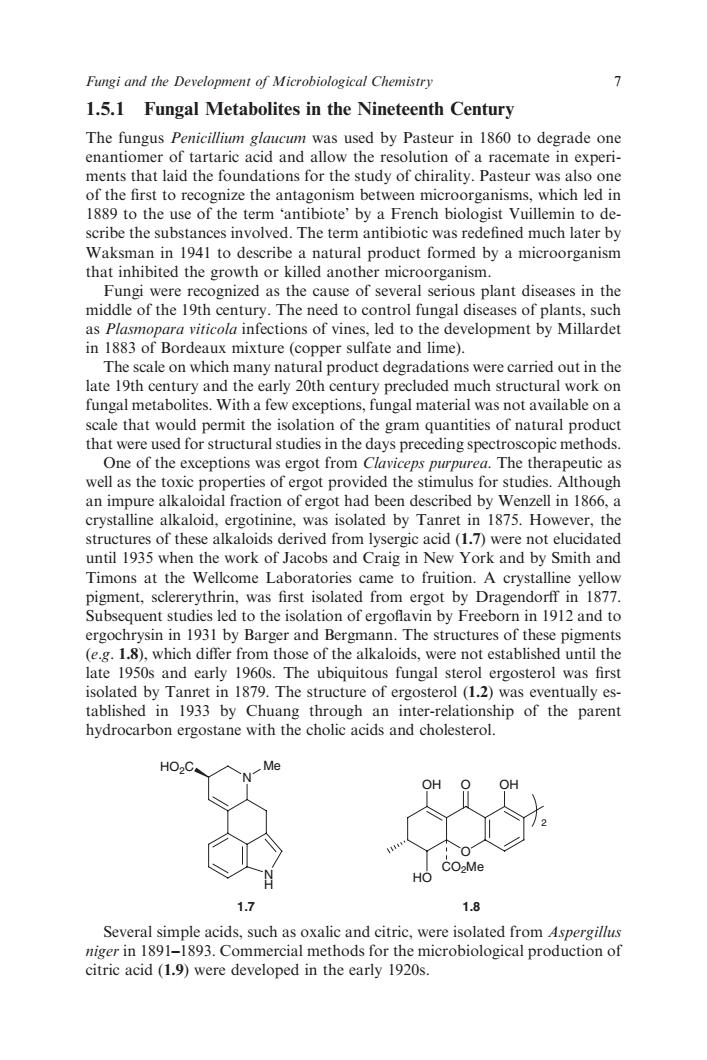正在加载图片...

Fungi and the Development of Microbiological Chemistry 1.5.1 Fungal Metabolites in the Nineteenth Century The fungus Penicillium glaucum was used by Pasteur in 1860 to degrade one er of tartaric acid and allow the resolution of a racemate in experi- laid the foundations for the study of chirality vas als of the first to which led i 1889t o the e term tibiote by a uillemin to de scribe the substances involved.The term antibiotic was redefined much later by Waksman in 1941 to describe a natural product formed by a microorganism that inhibited the growth or killed another microorganism. Fungi were recognized as the cause of several serious plant diseases in the middle of the 19th century.The need to control fungal diseases of plants,such viricola infections of vines,led to the development by Millardet in 1883 of Bo rde mixture(copper sulfat and月 e) scale on which ons were carried out in the late 19th century and d much structural work on fungal metabolites.With a few exceptions,fungal material was not available on a scale that would permit the isolation of the gram quantities of natural product that were used for structural studies in the days preceding spectroscopic methods. One of the exceptions was ergot from Claviceps purpurea.The therapeutic as well as the toxic r operties of ergot provided the stimulus for studies.Although an im tion o t had been described by Wenzell in 1866. alkaloid, solated by T anre et in lerived from 1.7)were e work of Jacobs and Craig in New York and by Smith and Timons at the Wellcome Laboratories came to fruition.A crystalline yellow pigment,sclererythrin,was first isolated from ergot by Dragendorff in 1877. Subsequent studies led to the isolation of ergoflavin by Freeborn in 1912 and to ergochrysin in 1931 by Barger and Bergmann.The structures of these pigments (e.g.1.8).which differ from those of the alkaloids,were not established u ntil the late 1950s and early 1960s.The ubiquitous fungal sterol ergosterol was firs olated by n 1879.The tually es ablished in 1933 ergosterol (1.2 by Chu hip of the paren hydrocarbon ergostane with the cholic acids and cholesterol. HO2C -Me OH CO Me 1.7 1.8 Several simple acids,such as oxalic and citric,were isolated from Aspergillus niger in 1891-1893.Commercial methods for the microbiological production of citric acid(1.9)were developed in the early 1920s. 1.5.1 Fungal Metabolites in the Nineteenth Century The fungus Penicillium glaucum was used by Pasteur in 1860 to degrade one enantiomer of tartaric acid and allow the resolution of a racemate in experiments that laid the foundations for the study of chirality. Pasteur was also one of the first to recognize the antagonism between microorganisms, which led in 1889 to the use of the term ‘antibiote’ by a French biologist Vuillemin to describe the substances involved. The term antibiotic was redefined much later by Waksman in 1941 to describe a natural product formed by a microorganism that inhibited the growth or killed another microorganism. Fungi were recognized as the cause of several serious plant diseases in the middle of the 19th century. The need to control fungal diseases of plants, such as Plasmopara viticola infections of vines, led to the development by Millardet in 1883 of Bordeaux mixture (copper sulfate and lime). The scale on which many natural product degradations were carried out in the late 19th century and the early 20th century precluded much structural work on fungal metabolites. With a few exceptions, fungal material was not available on a scale that would permit the isolation of the gram quantities of natural product that were used for structural studies in the days preceding spectroscopic methods. One of the exceptions was ergot from Claviceps purpurea. The therapeutic as well as the toxic properties of ergot provided the stimulus for studies. Although an impure alkaloidal fraction of ergot had been described by Wenzell in 1866, a crystalline alkaloid, ergotinine, was isolated by Tanret in 1875. However, the structures of these alkaloids derived from lysergic acid (1.7) were not elucidated until 1935 when the work of Jacobs and Craig in New York and by Smith and Timons at the Wellcome Laboratories came to fruition. A crystalline yellow pigment, sclererythrin, was first isolated from ergot by Dragendorff in 1877. Subsequent studies led to the isolation of ergoflavin by Freeborn in 1912 and to ergochrysin in 1931 by Barger and Bergmann. The structures of these pigments (e.g. 1.8), which differ from those of the alkaloids, were not established until the late 1950s and early 1960s. The ubiquitous fungal sterol ergosterol was first isolated by Tanret in 1879. The structure of ergosterol (1.2) was eventually established in 1933 by Chuang through an inter-relationship of the parent hydrocarbon ergostane with the cholic acids and cholesterol. O OH O OH HO CO2Me 2 1.8 N N H HO2C 1.7 Me Several simple acids, such as oxalic and citric, were isolated from Aspergillus niger in 1891–1893. Commercial methods for the microbiological production of citric acid (1.9) were developed in the early 1920s. Fungi and the Development of Microbiological Chemistry 7